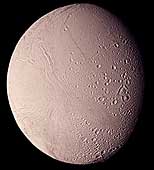|
COMETS EARTH JUPITER KUIPER BELT MARS MERCURY METEORITES NEPTUNE OORT CLOUD PLUTO SATURN SOLAR SYSTEM SPACE SUN URANUS VENUS ORDER PRINTS
PHOTO CATEGORIES SCIENCEVIEWS AMERICAN INDIAN AMPHIBIANS BIRDS BUGS FINE ART FOSSILS THE ISLANDS HISTORICAL PHOTOS MAMMALS OTHER PARKS PLANTS RELIGIOUS REPTILES SCIENCEVIEWS PRINTS
|
Related Document
Download Options
This Voyager 2 mosaic of Enceladus was made from images taken through the clear, violet and green filters on August 25, 1981, from a distance of 119,000 kilometers (74,000 miles). In many ways, the surface of this satellite of Saturn resembles that of Jupiter's Galilean satellite Ganymede. Enceladus, however, is only one-tenth Ganymede's size. Some regions of Enceladus show impact craters up to 35 kilometers (22 miles) in diameter, whereas other areas are smooth and uncratered. Linear sets of grooves tens of kilometers long traverse the surface and are probably faults resulting from deformation of the crust. The uncratered regions are geologically young and suggest that Enceladus has experienced a period of relatively recent internal melting. The rims of several craters near the lower center of the picture have been flooded by the smooth terrain. Features as small as 2 kilometers (1.2 miles) are visible in this highest-resolution view of Enceladus. |
||||||||||||||||||||||||||||||||||||
